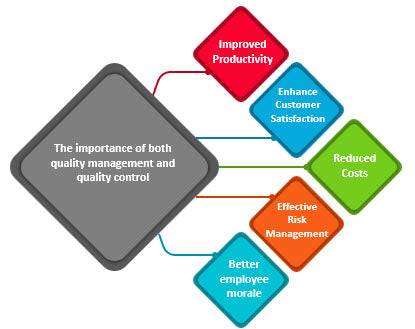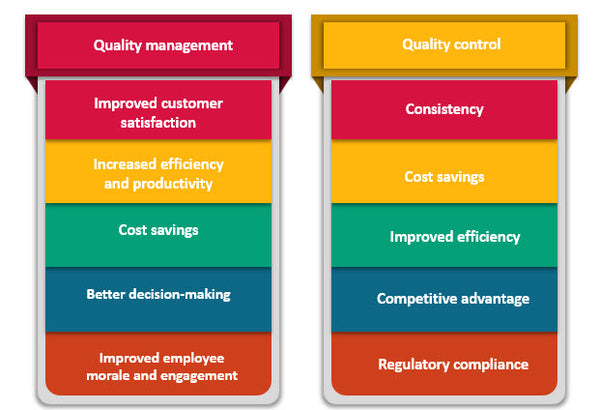Quality Management vs Quality Control Which is More Important?
Quality management and quality control are two interconnected terms that are often used interchangeably. While both terms focus on improving the quality of a product or service, they have different meanings and distinct purposes.

Quality management refers to the overall process of ensuring that the quality of products or services meets or exceeds expectations. It is a systematic approach that involves identifying, analyzing, and implementing strategies to improve quality. Quality management encompasses every aspect of an organization, from its management processes to its employees' education and training.
On the other hand, quality control is a specific set of procedures used to ensure that a product or service meets specific standards. It is a process of testing and inspecting products or services to ensure they comply with standards. Quality control activities include inspections, testing, and sampling of products or services to detect and eliminate defects.
In essence, quality management and quality control are complementary approaches to achieving high-quality products or services. Quality management provides a framework for achieving quality, whereas quality control provides specific techniques for verifying the quality of products or services. Both processes are essential in ensuring that an organization delivers high-quality products or services consistently.
What Is Quality Management?
Quality management refers to the process of ensuring that products or services are consistently meeting or exceeding customer expectations. It involves the implementation of efficient systems and processes that are designed to improve product or service quality, reduce errors and defects, and increase customer satisfaction. Quality management is essential for companies to achieve long-term success and maintain a competitive edge in the marketplace.
It helps to build trust and loyalty among customers, enhances brand reputation, and maximizes productivity and profitability. Quality management involves various activities such as setting quality objectives, measuring and analyzing performance, identifying improvement areas, implementing corrective measures, and continuous monitoring.
It also involves the involvement and empowerment of employees to contribute towards quality improvement initiatives. Quality management is an ongoing process that requires commitment from all levels of the organization. Effective quality management leads to enhanced customer satisfaction and loyalty, improved efficiencies, and better cost management.
What Is Quality Control?
Quality control is a systematic process in which products or services are examined or tested to ensure that they meet specified quality standards. The goal of quality control is to identify defects and deviations from the standards and to take corrective action to ensure that the product or service meets the required quality level. Quality control typically involves testing, inspection, and monitoring of the production or service process, as well as the final product or service. It is an essential aspect of ensuring customer satisfaction and protecting the reputation and profitability of a business.
Some common methods used in quality control include visual inspection, statistical process control, and quality audits. In visual inspection, the product is examined for visual defects such as scratches, dents, or discoloration. Statistical process control involves analyzing data from the production process to identify any variations that could cause defects. Quality audits involve a comprehensive review of the production or service process, including documentation, procedures, and personnel training.
Effective quality control depends on clear communication and strict adherence to established standards and procedures. It requires a commitment to continuous improvement and a willingness to invest in equipment, training, and resources necessary to achieve and maintain quality standards. Ultimately, quality control is a critical component of any business that seeks to compete on the basis of quality, reliability, and customer satisfaction.

Which is More Important: Quality Management or Quality Control?
Both quality management and quality control are essential for ensuring high-quality products and services. Quality management is a systematic approach to managing product or service quality throughout the entire lifecycle, from planning to delivery, while quality control is the process of ensuring that the product or service meets specific quality standards.
Both are important and complementary to each other, with quality management helping to identify areas for improvement, and quality control ensuring that the identified issues are addressed, and the product or service meets the desired level of quality.
An effective combination of quality management and quality control can result in increased customer satisfaction, improved business performance, and reduced costs. Therefore, it is important for organizations to implement both quality management and quality control strategies to ensure the quality of their products or services.
The Benefits of Quality Management
Quality Management Can Provide Several Benefits, Including:
Improved Customer Satisfaction: By implementing quality management, organizations can ensure that their products or services meet or exceed customer expectations, leading to improved customer satisfaction and loyalty.
Increased Efficiency and Productivity: Quality management systems help streamline processes, reduce errors and waste, and improve overall efficiency, resulting in increased productivity.
Cost Savings: By improving efficiency, reducing waste, and minimizing errors, quality management can help organizations reduce costs and improve profitability.
Better decision-making: Quality management provides reliable data and metrics that can help organizations make informed decisions and identify areas for improvement.
Improved Employee Morale and Engagement: Quality management systems involve employees in the process of continuous improvement, empowering them to identify and solve problems. This can lead to increased engagement and morale among employees.
Compliance with Regulations and Standards: Quality management systems can help organizations comply with regulations and standards, reducing the risk of non-compliance penalties and legal issues.
Competitive Advantage: By providing better products and services and improving efficiency, quality management can help organizations gain a competitive advantage in their industry.
The Benefits of Quality Control
- Consistency: Quality control ensures that a product or service is consistent in its quality, meaning that it will meet customer expectations every time.
- Customer Satisfaction: Customers are more likely to be satisfied with a product or service if it meets their quality expectations.
- Cost Savings: Quality control can help identify and correct issues early on, reducing the cost of fixing problems later.
- Improved Efficiency: By identifying and addressing quality issues, businesses can improve their processes and increase efficiency.
- Competitive Advantage: Offering high quality products or services is a competitive advantage that can lead to increased market share and customer loyalty.
- Regulatory Compliance: Quality control is often required by regulatory agencies to ensure compliance with standards and regulations.
- Reputation: Consistently delivering high quality products or services can enhance a company’s reputation and help attract more customers.
The Importance of Both Quality Management and Quality Control
- Improved Productivity: The implementation of quality management and quality control processes helps to identify and eliminate the root cause of defects in the production, thus reducing waste, resulting in better productivity.
- Enhance Customer Satisfaction: Ensuring the quality of products and services not only meets or exceeds customer expectations but also consistently delivers at every interaction. It will help to build trust and loyalty, which ultimately generates customer satisfaction.
- Reduced Costs: By removing the defects from the production cycle, quality control processes can reduce the number of returns, rejected products, and customer complaints, which can save cost in the long run.
- Effective Risk Management: By implementing quality management practices such as risk assessments, preventive actions, and corrective actions can identify and address potential issues before they become bigger problems.
- Better Employee Morale: With a robust quality management system in place, employees feel empowered to contribute to the quality of products and services, thus improving their morale.
Conclusion
In conclusion, both quality management and quality control are equally important for any organization that aims to provide quality products or services to its customers. Quality control focuses on detecting and correcting defects during the production process, while quality management focuses on continuous improvement and prevention of defects. Both approaches are necessary to ensure that the final product or service meets the customer's requirements and expectations. Therefore, a balance of both quality management and quality control practices should be adopted to achieve long-term success in any business.



